- The Illusive Castle of Nobunaga’s Dream
- 🚉 How to Get Here: Azuchi station
- 360° Panorama Photo Page
- Otemichi Main Approach
- Site of Maeda Toshiie’s Former Residence (Legend)
- Site of Hashiba (Toyotomi) Hideyoshi’s Former Residence (Legend)
- Enkeizan Soken-ji Temple
- Site of Takei Sekian’s Residence
- Tokutomi Sohō Poetry Monument
- Obake Lantern
- Site of Oda Nobutada’s Residence (Legend)
- Site of Mori Ranmaru’s Residence (Legend)
- Kurogane Gate Ruins
- Oda Nobukatsu’s Four Generations Memorial Pagoda
- Ninomaru South Belt Bailey Ruins
- Bussoku-seki (Buddha’s Footprint Stone)
- Oda Nobunaga’s Main Mausoleum
- Ninomaru Ruins
- Honmaru Ruins
- Tenshudai (Main Keep Base) Ruins
- Three-Story Pagoda
- Nio Gate
- Hearth Remains (Kamado Ato)
- Azuchi Castle – Complete Site Map
- Go to Outer Grounds Guide
- Back To Oda Nobunaga Site
- Back To Kyoto-Osaka Region
The Illusive Castle of Nobunaga’s Dream
Once on the brink of unifying the nation, Oda Nobunaga built Azuchi Castle as a symbol of authority and innovation. Its magnificent main keep and lavish decorations defied the conventions of the time. Even though its original form has long vanished, every remaining stone wall and ruin still speaks to Nobunaga’s ambition and refined aesthetic. Why not trace the memory of this legendary castle, where the romance of the Warring States era still lingers?
🚉 How to Get Here: Azuchi station
From Itami Airport:
Approx. travel time: 2 hours
Fare: 1,950 yen
From Kyoto Station:
Approx. travel time: 45 minutes
Fare: 770 yen
🔸Opening Hours
Open year-round, 8:30 AM – 5:00 PM (last admission at 4:00 PM)
Special Soji-ji Temple Visits: 8:30 AM – 3:00 PM (only on designated days)
🔸Admission Fees (as of 2025)
| Category | Individual Price |
|---|---|
| Adults (General) | 700 yen |
| High School Students and Younger | 200 yen |
*For the Special Soji-ji Temple Visit (held irregularly), an additional fee of 500 yen is required (includes matcha tea and sweets)
🚶 Access
JR Biwako Line: About 20 minutes on foot from Azuchi Station, about 10 minutes by rental bicycle,
approximately 7 minutes by taxi or car (free parking available)
360° Panorama Photo Page
Otemichi Main Approach
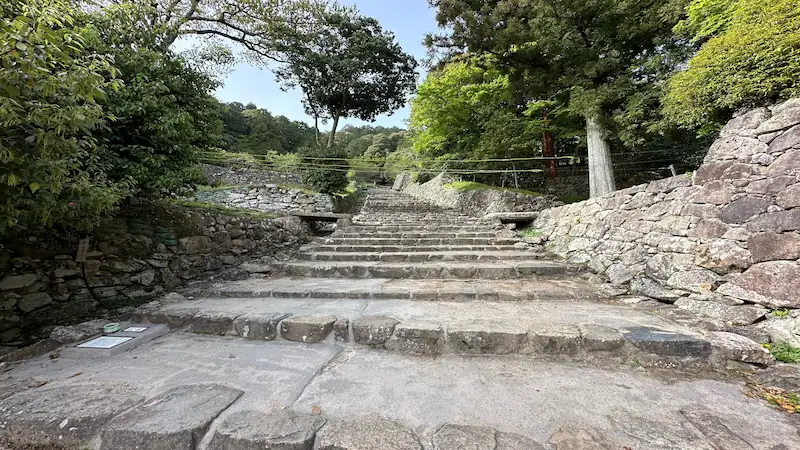
🏛 Overview
The “Otemichi” of Azuchi Castle is a grand stone staircase designed as the castle’s main entrance, impressing all who visit with its solemn dignity. Characterized by a straight stone stairway approximately 6 meters wide and 180 meters long, it was an extraordinary scale and design for castle architecture of its time. It is said that Nobunaga specially designed this path to welcome an imperial visit, symbolizing the castle’s prestige and formality. Today, the stone steps and walls remain in remarkably good condition, preserving the splendor of that era.
🗺 Address: Azuchi-cho Shimo Toyoura, Omihachiman City, Shiga Prefecture
🚶 Access
After paying the admission fee, you’ll see it right in front of you.
⏳ Recommended Visit Time
Quick Highlights: about 10 minutes For a thorough visit: about 30 minutes
📍 Highlights
- The Striking Linear Beauty of the Stone Steps: A straight stone staircase stretching approximately 6 meters wide and 180 meters long—a unique design not seen in other castles.
- Ruins of Samurai Residences: Along both sides of the Otemichi are the remnants of the residences of Nobunaga’s senior retainers, such as Hashiba Hideyoshi and Maeda Toshiie, evoking the original layout of the time.
- Reused Stones: You can spot “reused stones,” such as repurposed gravestones, incorporated into the staircase, reflecting the ingenuity of the castle’s construction.
- Seasonal Beauty: In spring, cherry blossoms bloom spectacularly, and in autumn, vibrant foliage adorns the Otemichi approach.
📌 Trivia
- Surprising Historical Background: It is believed that the Otemichi was designed to welcome an imperial visit, serving as an important avenue showcasing Nobunaga’s authority.
- Little-Known Details: The stone steps of the Otemichi feature repurposed gravestones and other materials, known as “reused stones.”
- Famous Connections: Residences of Nobunaga’s top generals, such as Hashiba Hideyoshi and Maeda Toshiie, were lined up along the Otemichi approach.
Site of Maeda Toshiie’s Former Residence (Legend)
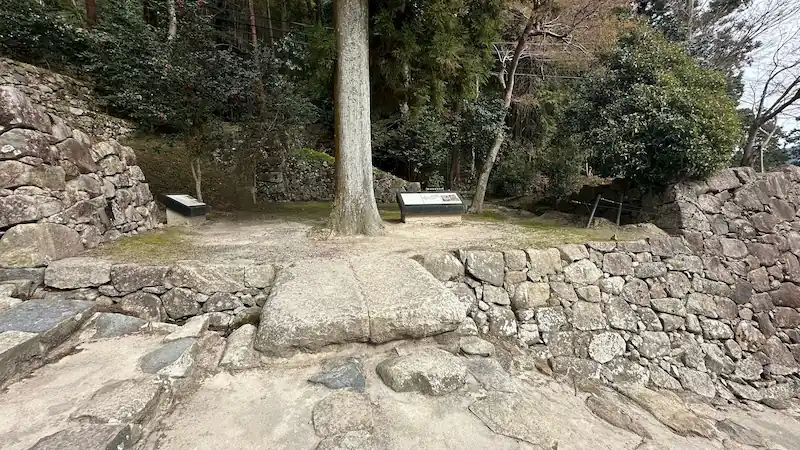
Click here to view the panorama photos
🏛 Overview
Located on the right side of the Otemichi main approach immediately after paying the admission fee, the “Site of Maeda Toshiie’s Residence” is traditionally believed to be where Maeda Toshiie, a powerful retainer of Oda Nobunaga who later laid the foundation for the vast Kaga Domain, once lived. Today, no buildings remain, but the surviving stone walls and foundation stones convey its historical atmosphere. The residence was built by reshaping the steep slope into several terraced enclosures, resulting in a complex layout. In the southwest corner of the property, it is thought that a corner turret was erected to guard the Otemichi, though it was largely destroyed in later centuries, so details remain uncertain. Just inside the gate was a small square called a *masugata*, which was enclosed to the east and north by an L-shaped *tamonyagura* gallery turret. These ruins are precious clues for understanding samurai residences at the end of the 16th century.
🗺 Address: Azuchi-cho Shimo Toyoura, Omihachiman City, Shiga Prefecture
🚶 Access
It comes into view on your immediate right after paying the admission fee.
⏳ Recommended Visit Time
Quick highlights: about 5 minutes For an in-depth visit: about 20 minutes
📍 Highlights
- Remains of the *Koguchi* Gate: This was the entrance area to the residence. A gap was cut into the stone embankment built along the Otemichi to create the entry, forming an “inner masugata,” a small square space inside the gate.
- Three-Tiered Stone Walls: To the left after entering the gate, an impressive three-tiered stone wall rises up to about 6 meters high, from which a tamonyagura gallery turret looked down over any approaching enemies.
- Wooden Drain Remains: A wooden drainage facility discovered beneath the floor of the tamonyagura, believed to have been used to carry away water from washing areas.
- Seasonal Scenery: In spring, the surrounding cherry blossoms are stunning, while autumn brings vibrant foliage.
📌 Trivia
- Surprising Historical Background: The koguchi gate here features a highly defensive structure reminiscent of early modern castle design, showing that such techniques were already adopted during Azuchi Castle’s construction.
- Little-Known Details: In the lowest enclosure of the residence stood a stable that could house three horses. Remarkably, its layout matches the “Sangen Umaya-no-zu” (Three-Bay Stable Plan) illustrated in *Shoumei*, an early Edo-period carpentry manual.
- Famous Connections: Maeda Toshiie’s lawful wife, Matsu (Hoshun’in), took Buddhist vows after his death and founded the Hoshun’in Temple at Daitoku-ji in Kyoto, greatly contributing to the prosperity of the Maeda family.
Site of Hashiba (Toyotomi) Hideyoshi’s Former Residence (Legend)
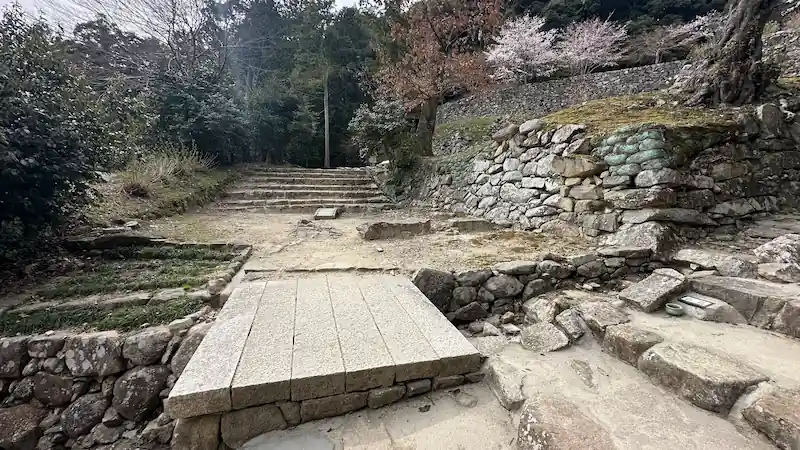
Click here to view the panorama photos
🏛 Overview
Situated along the Otemichi main approach of Azuchi Castle, the “Site of Hashiba (Toyotomi) Hideyoshi’s Residence” is traditionally believed to have been the dwelling place of Hideyoshi, who once served Oda Nobunaga. Although no buildings remain today, the stone walls and foundation stones offer glimpses into the layout of the residence. The compound was structured into two terraced enclosures: the lower level is thought to have contained the turret gate, while the upper level housed the main hall. The turret gate was designed with a gate on the first floor and a watchtower on the second—a style widely adopted in later early modern castles. This particular example is considered one of the oldest known. These remains are invaluable for understanding the architecture and spatial organization of samurai residences at the end of the Sengoku period, providing insight into the daily life of military leaders.
🗺 Address: Azuchi-cho Shimo Toyoura, Omihachiman City, Shiga Prefecture
🚶 Access
Directly across the Otemichi from the Site of Maeda Toshiie’s Residence
⏳ Recommended Visit Time
Quick highlights: about 5 minutes For an in-depth visit: about 20 minutes
📍 Highlights
- Turret Gate Remains: Located at the entrance to the lower enclosure, this gate—with its first floor as an entryway and second floor as a watchtower—is regarded as the oldest example of a turret gate seen in early modern castles.
- Stable Remains: Just past the turret gate was a large stable capable of housing six horses.
- Main Hall Remains: Situated in the upper enclosure, this area contained the lord’s living quarters, including a formal entrance hall, attendants’ rooms, the main hall, and an inner kitchen.
- Seasonal Scenery: In spring, the area is graced by beautiful cherry blossoms, while autumn offers spectacular displays of colored foliage.
📌 Trivia
- Surprising Historical Background: The turret gate here is known as the oldest surviving example of its kind among early modern castle gates.
- Little-Known Details: The lower enclosure was mainly an open space containing only a single stable—an essential facility for a samurai residence.
- Famous Connections: This site, believed to have been Hideyoshi’s residence, is one of the symbolic locations representing his remarkable rise to power.
Enkeizan Soken-ji Temple
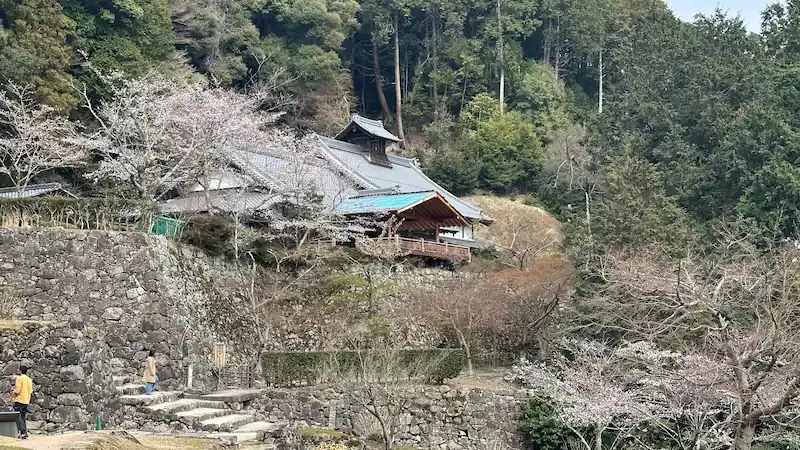
🏛 Overview
Enkeizan Soken-ji Temple is a Zen temple belonging to the Myoshin-ji branch of the Rinzai sect, located within the Azuchi Castle ruins in Omihachiman City, Shiga Prefecture. It was founded during the Tensho era (1573–1592) by Oda Nobunaga, who established it as his family temple alongside the construction of Azuchi Castle. At its inception, many structures were relocated here from nearby shrines and temples, and it is said there were once 22 buildings on the grounds. However, in 1854 (Kaei 7), a fire destroyed the main hall and other significant structures, and the current provisional main hall was rebuilt on the site of Tokugawa Ieyasu’s former residence. The temple grounds still contain several important historical features, including a three-story pagoda and the Niomon Gate, both designated National Important Cultural Properties, attracting many visitors drawn to their cultural and historical value.
🗺 Address: 6367 Azuchi-cho Shimo Toyoura, Omihachiman City, Shiga Prefecture
🚶 Access
Located uphill on the right from the Site of Hashiba Hideyoshi’s Residence along the Otemichi approach
⏳ Recommended Visit Time
Quick highlights: about 10 minutes For a thorough visit: about 30 minutes
📍 Highlights
- Three-Story Pagoda: A three-bay, three-story pagoda built in 1454 (Kyotoku 3) during the Muromachi period, designated a National Important Cultural Property.
- Niomon Gate: A two-story gate constructed in 1571 (Genki 2), said to have been moved here by Nobunaga from Koka. It is also designated a National Important Cultural Property and houses statues of the Nio guardians within.
- Provisional Main Hall: Erected in 1932 on the site of Tokugawa Ieyasu’s former residence. On special occasions, visitors can view the statue of Nobunaga and sliding door paintings inside.
- Seasonal Scenery: In spring, cherry blossoms beautifully adorn the temple grounds, while autumn brings breathtaking fall colors.
📌 Trivia
- Surprising Historical Background: Soken-ji was established by Nobunaga by relocating many structures from surrounding shrines and temples, giving it exceptional value as a collective of historical architecture.
- Little-Known Details: During special openings of the provisional main hall, visitors can view Nobunaga’s statue and the sliding door paintings, as well as enjoy tea served in the tea room.
- Famous Connections: Founded by Oda Nobunaga as his family temple, Soken-ji continued to flourish as the ancestral temple of the Oda clan.
Site of Takei Sekian’s Residence
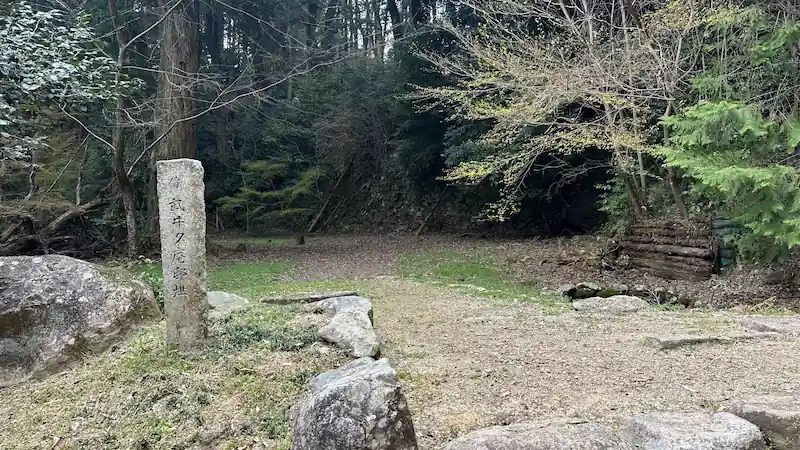
🏛 Overview
As you proceed along the Otemichi approach within the Azuchi Castle ruins, you’ll come to the site traditionally believed to have been the residence of Takei Sekian, a close advisor and chief secretary (*yuhitsu*) to Oda Nobunaga. Takei Sekian was one of Nobunaga’s most trusted retainers, playing key roles in diplomatic negotiations and important ceremonies. Although the residence itself no longer exists, the grounds still contain remains of a pond and a well, offering glimpses into aspects of daily life at that time.
🗺 Address: Azuchi-cho Shimo Toyoura, Omihachiman City, Shiga Prefecture
🚶 Access
Located uphill on the left from Enkeizan Soken-ji Temple along the Otemichi approach
⏳ Recommended Visit Time
- Quick highlights: about 5 minutes; for a deeper exploration: about 15 minutes
📍 Highlights
- Pond Remains: The remains of a pond hint at the gardens that once adorned the residence.
- Well Remains: You can also see traces of a well that supplied water for daily use.
- Seasonal Scenery: In spring, the surrounding cherry blossoms create a picturesque setting to enjoy alongside the historic ruins.
📌 Trivia
- Surprising Historical Background: Takei Sekian originally served the Saito clan of Mino Province before joining Nobunaga, later becoming his chief secretary and playing crucial roles in diplomatic affairs.
- Little-Known Details: Near the site of Takei Sekian’s residence are the remains of other senior retainers’ homes, including those of Maeda Toshiie and Hashiba Hideyoshi.
- Famous Connections: Takei Sekian was so trusted by Nobunaga that he was said to be the only person outside of Nobunaga’s own family who could offer direct counsel to him.
Tokutomi Sohō Poetry Monument
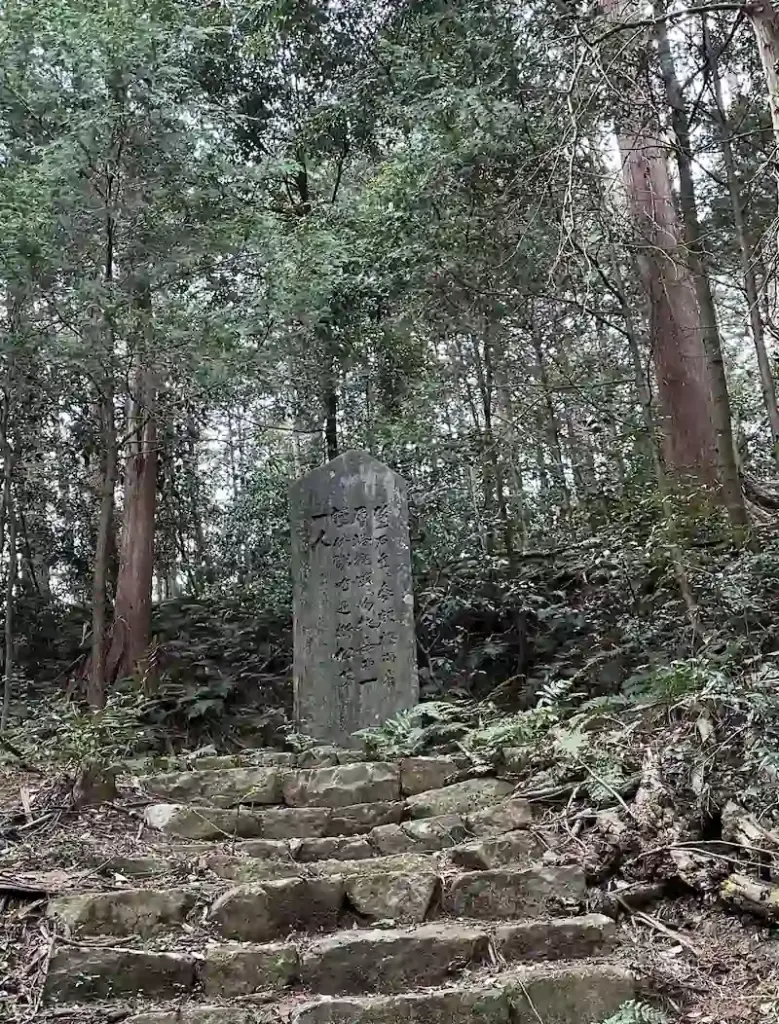
This stone monument features a Chinese poem by Tokutomi Sohō (1863–1957), a prominent writer, historian, and critic of the Meiji, Taisho, and Showa eras. It was erected to commemorate Sohō’s contributions to the preservation and development of the Azuchi Castle ruins beginning in 1918. After the site was designated a Special Historic Site by the Japanese government in 1926 (Taisho 15), the chief priest of Soken-ji Temple, Matsuoka Hanshu, and others led restoration efforts and invited Sohō to inscribe the monument. The poem itself is carved on the front, while the back records the circumstances of its creation, with inscriptions by Sohō and his guide, Nakagawa Senzō.
| Year Built | Circa 1938 (Showa 13) |
|---|---|
| Creators | Tokutomi Sohō (poem and calligraphy), Nakagawa Senzō, and local supporters |
| Structure & Features | Stone monument engraved with Sohō’s Chinese poem; back records the history of its erection |
| Restoration History | Erected during site development; no major repairs |
| Current Condition | Existing |
| Damage or Loss | None |
| Cultural Designation | Associated Historic Site within the Special Historic Site of Azuchi Castle Ruins |
| Notes | Related to other stone markers inscribed by Sohō (Ote Entrance, Dodo Bridge Entrance, etc.) |
🗺 Address: Azuchi Castle Ruins, Shimo Toyoura, Azuchi-cho, Omihachiman City, Shiga Prefecture
🚶 Access:
Located up the Otemichi from the Site of Oda Nobutada’s Residence, along a small path on the right
⏳ Recommended Visit Time
Quick highlights: about 5 minutes; for a more in-depth visit: about 15 minutes
📍 Highlights
- Front of the Monument: Sohō’s Chinese poem is boldly engraved, creating a dignified presence enhanced by the stone’s natural texture
- Back of the Monument: The inscription records the story behind the monument’s creation and lists supporters such as Senzō
- Surrounding Scenery: A peaceful walking path harmonizing dappled sunlight with ancient stone walls
📌 Trivia
- Surprising Historical Background: Sohō gave a lecture in 1933 (Showa 8) on the 350th anniversary of Nobunaga’s death, deepening his interest in Azuchi and supporting preservation efforts
- Little-Known Details: In addition to this monument, Sohō’s calligraphy marks other stones bearing the inscription “Azuchi Castle Site” at the Ote Entrance, Dodo Bridge Entrance, and East Back Gate
- Famous Connections: Nakagawa Senzō, the guide, was a respected local historian who helped compile regional topographies and played a central role in the monument’s creation
The Tokutomi Sohō Poetry Monument is more than just a stone marker—it is a “second-generation historic site” that embodies the passion of a modern Japanese historian and writer. Each carved character reflects the spirit of Azuchi Castle’s revival and Sohō’s convictions.
🧭 About Tokutomi Sohō
- Born–Died: 1863 (Bunkyū 3) – 1957 (Showa 32)
- Birthplace: Kumamoto Domain (present-day Kumamoto Prefecture)
- Occupations and Activities
- Founder of the newspaper *Kokumin Shimbun*
- Historical critic and journalist
- Member of the House of Peers
- Promoter of Japanese history and nationalist thought
- Evolution of Thought
- Sympathized with the Freedom and People’s Rights Movement in his youth
- Shifted toward nationalism during the Sino-Japanese and Russo-Japanese Wars
- In his later years, published writings supportive of wartime cooperation
He was especially dedicated to promoting awareness of key figures in the Meiji Restoration and to educating the public about modern Japanese history, leading him to play a major role in preserving and commemorating historic sites nationwide.
🏯 Why Azuchi Castle?
In 1928 (Showa 3), Sohō contributed to erecting the “Azuchi Castle Site” marker at the Ote Entrance and was actively involved in promoting the site’s recognition. The memorial ceremony in 1932 (Showa 7) marking the 350th anniversary of Nobunaga’s death became a catalyst for further efforts. In 1940 (Showa 15), this poetry monument was finally erected beside the castle’s main enclosure.
This ceremony inspired Sohō to view Azuchi Castle as a “symbol of Nobunaga’s spirit” and deepened his commitment to preserving and commemorating the site.
Together with Soken-ji’s chief priest, Matsuoka Hanshu, and local volunteers, he helped to:
- Establish the “Azuchi Castle Site” markers at the Ote Entrance and Dodo Bridge Entrance (Ote Entrance marker erected in 1928)
- Erect the Tokutomi Sohō Poetry Monument beside the main enclosure (erected in 1940)
and contributed inscriptions and support to these commemorative efforts.
🏛 Other Preservation and Commemoration Activities
Beyond Azuchi Castle, Sohō contributed calligraphy and writings for numerous historical monuments across Japan.
Notable examples:
- Nijo Castle (Kyoto) – Supported preservation efforts
- Kumamoto Castle – Wrote extensively in recognition of his home region’s heritage
- Aizu Byakkotai Graves – Contributed to historical commemoration
- Memorial to Admiral Togo Heihachiro
Throughout the Taisho and early Showa eras, he gave many lectures and published widely to promote castle preservation efforts nationwide.
Obake Lantern
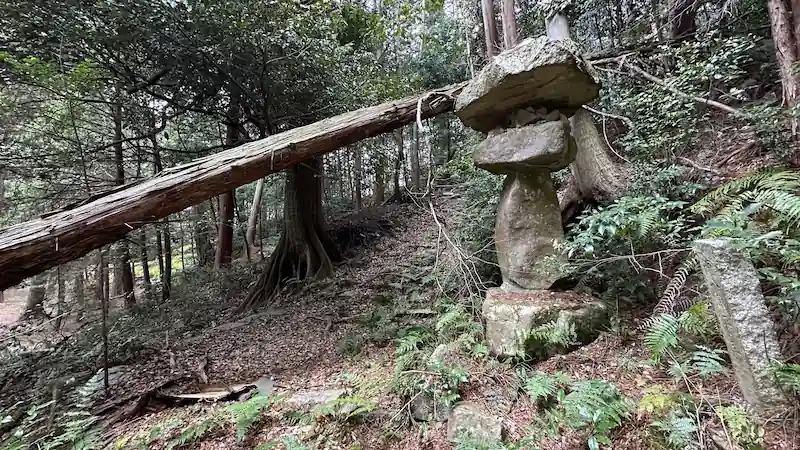
Located near the end of the Otemichi main approach at the Azuchi Castle ruins, the so-called “Obake Lantern” is a historical landmark whose origins actually date not to Nobunaga’s era but to the early Edo period, around the Kan’ei era (circa 1631). This towering stone lantern stands approximately 3 meters high and is built by stacking natural stones with minimal shaping except for the firebox. Its raw, unadorned form preserves the natural beauty admired at the time, making it a unique and striking feature.
| Year Built | Early Edo Period (Kan’ei 8 / ~1631) |
|---|---|
| Creator | Unknown (installed by early Edo-period visitors) |
| Structure & Features | Large stone lantern constructed by stacking natural stones; only the firebox is shaped |
| Restoration History | None; preserved in its natural state |
| Current Condition | Extant on site, set beside the castle approach |
| Damage or Loss | None |
| Cultural Designation | No specific designation; located within the Special Historic Site of Azuchi Castle Ruins |
| Notes | Visitors often leave small stones atop the lantern cap as mementos |
🗺 Address: Azuchi Castle Ruins, Omihachiman City, Shiga Prefecture
🚶 Access:
Visible along a small path on the right after climbing the Otemichi past the Site of Oda Nobutada’s Residence
⏳ Recommended Visit Time
Quick highlights: about 5 minutes; for a deeper exploration: about 15 minutes
📍 Highlights
- Main Lantern: A solemn, natural stone structure where visitors can place their own stones to “leave their mark on history”
- Stone Marker at the Junction: Reveals the layout of old climbing routes where paths merged and split
- Stacked Stones: Small pebbles left by visitors since the Showa era, each carrying personal memories
📌 Trivia
- Surprising Historical Background: Contrary to popular belief, the lantern does not date to Nobunaga’s time but was installed during the early Edo period for visitors
- Little-Known Details: Located near the end of the zigzag “Nanamagari” approach, so it’s easy to miss if you stay on the main route
- Famous Connections: Although no specific prominent figures are linked to its construction, the lantern was cherished by pilgrims and visitors throughout the Edo period
Site of Oda Nobutada’s Residence (Legend)
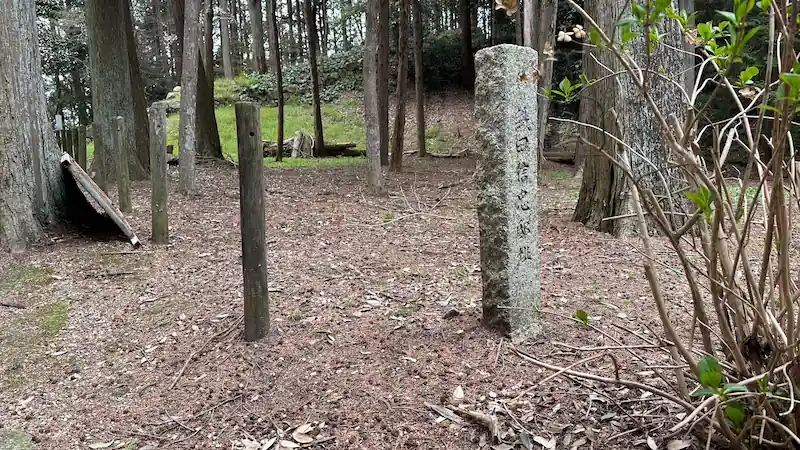
🏛 Overview
Midway up the Azuchi Castle ruins, at the intersection of the Otemichi and Dodo Bridge approaches, lies the site traditionally believed to have been the residence of Oda Nobutada, the eldest son of Oda Nobunaga. Nobutada was designated as Nobunaga’s heir and expected to lead the Oda clan into the future. However, in 1582, he perished alongside his father during the Incident at Honnō-ji.
Today, no structures remain on this site, but a commemorative stone marker stands to inform visitors of its history. Nearby, you will also find the poetry monument of Tokutomi Sohō, dedicated to Azuchi-yama.
This residence occupied a strategically important location for the castle’s defense, surrounded by the sites of other senior retainers’ homes. For history enthusiasts, it offers a rare glimpse into the lifestyles and strategies of Sengoku-period warlords.
🗺 Address: Shimo Toyoura, Azuchi-cho, Omihachiman City, Shiga Prefecture
🚶 Access
From the Tokutomi Sohō Poetry Monument, return to the Otemichi and continue onward; you’ll find it ahead on the route.
⏳ Recommended Visit Time
- Quick highlights: about 5 minutes; for a more in-depth visit: about 15 minutes
📍 Highlights
- Stone Marker: The commemorative stone indicating Nobutada’s residence, evoking the atmosphere of the era
- Tokutomi Sohō’s Poetry Monument: A monument dedicated to Azuchi-yama, offering a literary perspective on the site
- Seasonal Scenery: In spring, cherry blossoms beautifully complement the historical remains, creating a memorable setting
📌 Trivia
- Surprising Historical Background: Although designated as heir to the Oda clan, Nobutada was unable to fulfill this destiny, as he perished alongside his father during the Honnō-ji Incident
- Little-Known Details: Near this site lies the former residence of Takei Sekian, offering insight into the arrangement of retainers’ dwellings
- Famous Connections: Nobutada was the favored son and chosen successor of Nobunaga, entrusted with the future of the Oda clan
Site of Mori Ranmaru’s Residence (Legend)
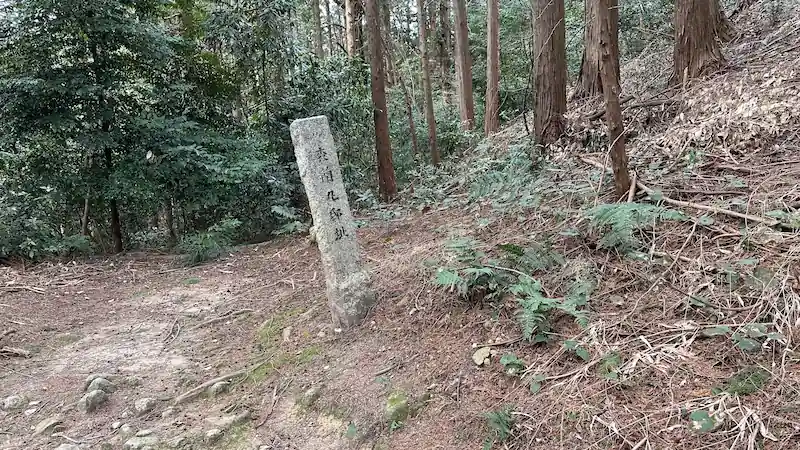
🏛 Overview
Located along the Otemichi main approach before the Kurogane Gate ruins, the “Site of Mori Ranmaru’s Residence” is traditionally believed to have been the dwelling of Mori Ranmaru (real name: Mori Naritoshi), the famed page and close attendant of Oda Nobunaga. Today, no buildings remain, but remnants such as stone walls and foundation stones evoke the atmosphere of the past. The residence was situated in a prominent area of Azuchi Castle, reflecting Ranmaru’s trusted status as Nobunaga’s personal attendant. Ranmaru is remembered for his loyalty and for perishing alongside Nobunaga during the Incident at Honnō-ji in 1582.
🗺 Address: Shimo Toyoura, Azuchi-cho, Omihachiman City, Shiga Prefecture
🚶 Access
From the Site of Oda Nobutada’s Residence, continue uphill toward the main keep; the site appears on the left.
⏳ Recommended Visit Time
Quick highlights: about 5 minutes; for a more in-depth visit: about 15 minutes
📍 Highlights
- Stone Wall Remains: The surviving stone walls mark the residence boundaries and showcase Sengoku-era construction techniques.
- Kurogane Gate Ruins: Nearby lies the Kurogane Gate, once a major entrance to Azuchi Castle, underscoring the importance of Ranmaru’s residence location.
- Seasonal Scenery: In spring, the area is adorned with cherry blossoms, while autumn offers beautiful fall colors.
📌 Trivia
- Surprising Historical Background: Mori Ranmaru’s position near the main entrance reflects the deep trust Nobunaga placed in him as a close attendant.
- Little-Known Details: Near the Kurogane Gate ruins is the site believed to have been the residence of Oda Nobuzumi, suggesting this area was home to Nobunaga’s relatives and most trusted retainers.
- Famous Connections: Mori Ranmaru loyally served Nobunaga and died alongside him during the Honnō-ji Incident.
Kurogane Gate Ruins
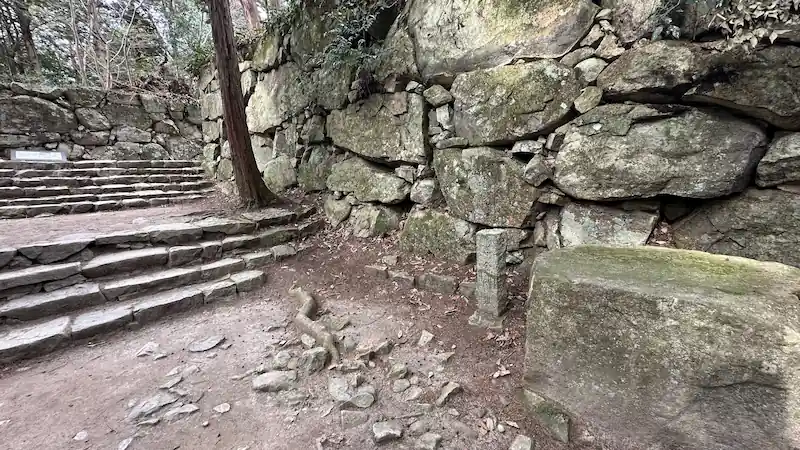
🏛 Overview
The Kurogane Gate Ruins mark the principal entrance to the heart of Azuchi Castle and are among the most impressive defensive features remaining today. Located near the mountaintop where the main keep and honmaru were once situated, this gate served as the first checkpoint for those entering the core compound. The surrounding stone walls are particularly notable for the exceptionally large stones used in their construction, designed to leave a powerful impression on visitors and would-be attackers alike. While the gate itself has not survived, the distinctive stonework and *koguchi* (gateway) layout vividly convey its historical importance.
🗺 Address: Shimo Toyoura, Azuchi-cho, Omihachiman City, Shiga Prefecture
🚶 Access
From the Site of Mori Ranmaru’s Residence, continue uphill toward the main keep and you’ll find it ahead.
⏳ Recommended Visit Time
Quick highlights: about 5 minutes; for a deeper exploration: about 15 minutes
📍 Highlights
- Massive Stone Walls: The walls around the Kurogane Gate feature some of the largest stones used in the castle, underscoring both its defensive strength and symbolic authority.
- Masugata Koguchi Layout: The approach makes two right-angle turns in a “masugata” style, an ingenious design to slow intruders and expose them to defenders.
- Seasonal Scenery: Cherry blossoms in spring and vibrant autumn foliage enhance the historic atmosphere.
📌 Trivia
- Surprising Historical Background: Excavations in 1993 revealed that the Kurogane Gate area was destroyed by fire along with the main keep. Among the charred debris were gilded roof tiles adorned with chrysanthemum and paulownia crests.
- Little-Known Details: The passage through the Kurogane Gate turns twice at right angles, flanked by massive stone walls. Because these wide embankments were faced on both sides with stone, they are technically called *ishirui* (stone ramparts).
- Famous Connections: Beyond the Kurogane Gate lay the castle’s innermost precincts, where Nobunaga and his closest retainers lived and governed.
- What “Kurogane” Means: “Kurogane” refers to “black iron.” While castle gates were typically wooden, attackers could easily burn them by piling dry grass against the doors. To prevent this, the surface of the gate was covered with iron plates, giving rise to the name “Kurogane Gate.”
Oda Nobukatsu’s Four Generations Memorial Pagoda
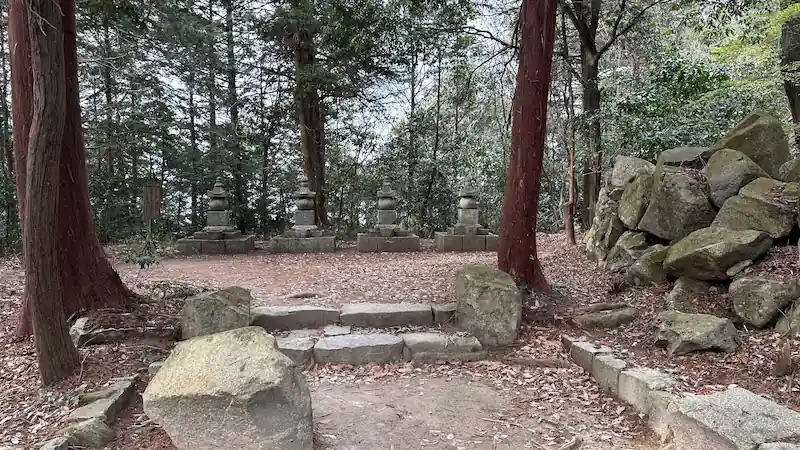
🏛 Overview
In one corner of the Azuchi Castle ruins, on the site traditionally believed to be the former residence of Hasegawa Hidekazu, stands the “Oda Nobukatsu Four Generations Memorial Pagoda.” Oda Nobukatsu (1558–1630) was the second son of Oda Nobunaga. Even after his father’s death, he managed to maintain his status as a daimyo and passed on the family line well into the Edo period. This stone memorial is said to have been erected to honor the spirits of Nobukatsu and four generations of his descendants. Today, it is an important historic site where visitors and history enthusiasts can reflect on the enduring legacy of the Oda clan.
🗺 Address: Shimo Toyoura, Azuchi-cho, Omihachiman City, Shiga Prefecture
🚶 Access
From the Kurogane Gate Ruins, continue toward the main keep, then enter the small path on the left.
⏳ Recommended Visit Time
Quick highlights: about 10 minutes; for a more in-depth visit: about 25 minutes
📍 Highlights
- Memorial Pagoda: A stone tower dedicated to Oda Nobukatsu and four generations of his descendants, valued for its historical significance.
- Surrounding Stone Walls: Remnants of the former samurai residence walls evoke the site’s long history.
- Seasonal Scenery: In spring, the cherry blossoms are breathtaking; in autumn, the colorful foliage creates a beautiful backdrop.
📌 Trivia
- Surprising Historical Background: Even after Nobunaga’s death, Nobukatsu managed to maintain his daimyo status and preserve the family line into the Edo period.
- Little-Known Details: The pagoda stands on what is believed to have been the former residence of Hasegawa Hidekazu, offering a sense of layered historical connections.
- Famous Connections: Nobukatsu was the second son of Oda Nobunaga and continued the Oda family’s legacy beyond his father’s time.
Ninomaru South Belt Bailey Ruins
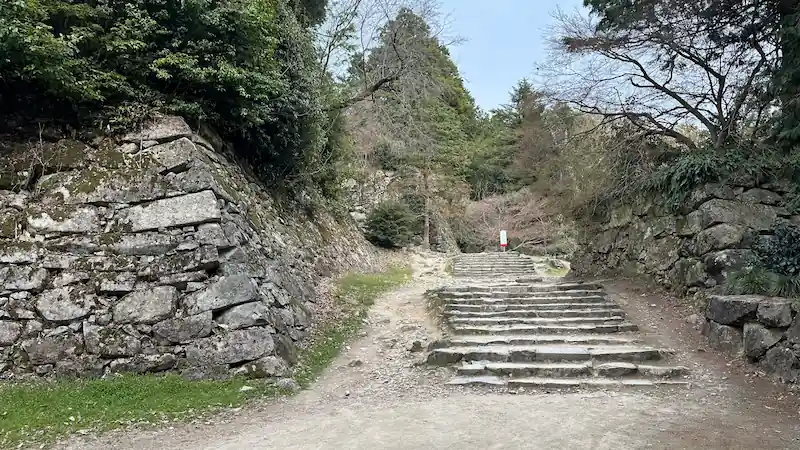
🏛 Overview
The Ninomaru South Belt Bailey Ruins are located along the southern side of the Ninomaru enclosure at Azuchi Castle. This long, narrow *belt bailey* (*obikuruwa*) played a crucial role in reinforcing the castle’s defenses and improving functionality. Belt baileys were built around the perimeter of main enclosures, forming defensive lines to deter attackers, while also serving as spaces to deploy troops and store supplies. Although no buildings remain today, the preserved stone walls and distinctive terrain still hint at the original layout and purpose of this fortification.
🗺 Address: Shimo Toyoura, Azuchi-cho, Omihachiman City, Shiga Prefecture
🚶 Access
From the Oda Nobukatsu Four Generations Memorial Pagoda, return to the Otemichi main approach and continue uphill toward the main keep.
⏳ Recommended Visit Time
Quick highlights: about 5 minutes; for a more in-depth visit: about 15 minutes
📍 Highlights
- Stone Wall Remains: Sections of the original stone walls survive, offering a glimpse into the construction techniques of the Sengoku period.
- Distinctive Terrain: The long, belt-shaped layout is characteristic of *obikuruwa*, revealing how the bailey fit into the castle’s layered defenses.
- Seasonal Scenery: Cherry blossoms in spring and vibrant autumn foliage make this area particularly scenic for a walk.
📌 Trivia
- Surprising Historical Background: Belt baileys were arranged to encircle the main enclosures, not only preventing enemy infiltration but also serving as thoroughfares and supply routes inside the castle.
- Little-Known Details: Compared to other Japanese castles, Azuchi Castle’s Ninomaru South Belt Bailey was notably large, demonstrating Nobunaga’s advanced approach to fortress design.
- Famous Connections: As part of Nobunaga’s innovative Azuchi Castle, this bailey remains a testament to his forward-thinking architectural vision.
Bussoku-seki (Buddha’s Footprint Stone)
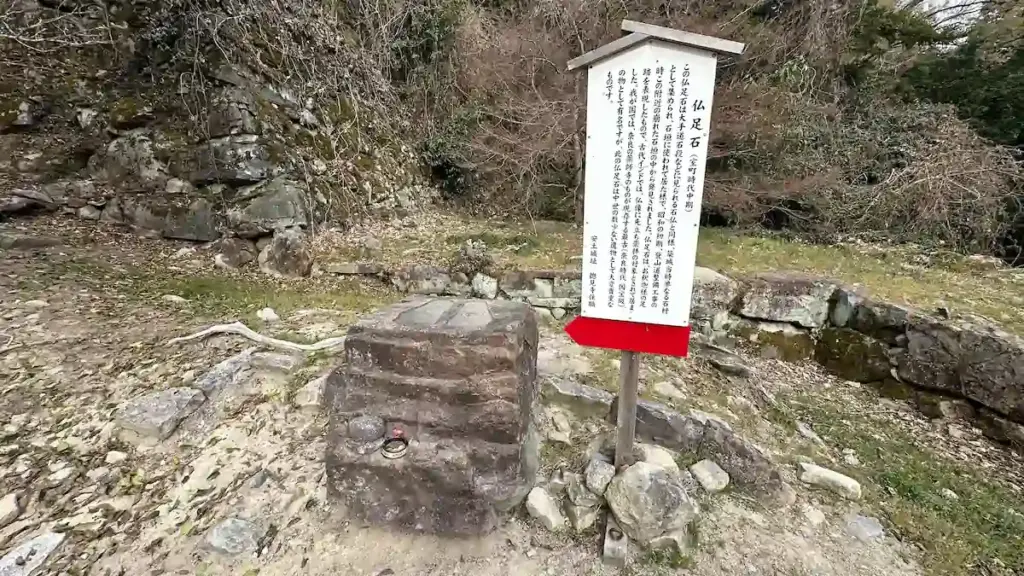
Click here to view the panorama photos
🏛 Overview
Near the Ninomaru area of the Azuchi Castle ruins lies a *Bussoku-seki*, or “Buddha’s Footprint Stone.” This sacred stone bears a carving of the Buddha’s footprint, a revered object of devotion that predates the widespread use of Buddha statues in ancient India. In Japan, the oldest known example is the National Treasure at Yakushiji Temple in Nara, dating to the Nara period. The Bussoku-seki at Azuchi Castle is an exceptionally rare medieval relic of considerable historical importance.
It is believed this stone was reused as part of the stone walls during the castle’s construction.
🗺 Address: Shimo Toyoura, Azuchi-cho, Omihachiman City, Shiga Prefecture
🚶 Access
From the Ninomaru South Belt Bailey Ruins, continue up the Otemichi approach toward the main keep to find it.
⏳ Recommended Visit Time
Quick highlights: about 5 minutes; for a more in-depth visit: about 15 minutes
📍 Highlights
- Bussoku-seki: The engraved footprint of the Buddha, regarded as an artifact of high cultural value.
- Remnants of Stone Walls: Parts of the wall where the Bussoku-seki was reused still survive, illustrating the castle’s ingenious construction methods.
- Seasonal Scenery: In spring, cherry blossoms adorn the site, while vibrant autumn colors create a striking contrast against the stonework.
📌 Trivia
- Surprising Historical Background: The Bussoku-seki predates the creation of Buddha statues and was used as a primary focus of devotion; the Yakushiji example in Nara is Japan’s oldest and most famous.
- Little-Known Details: At Azuchi Castle, many stone Buddhas and gorintō (five-ring pagodas) were similarly repurposed into walls and steps during construction, reflecting the builders’ resourcefulness.
- Famous Connections: As a castle built by Oda Nobunaga, the presence of the Bussoku-seki highlights the complex blend of religious belief and cultural influences of the period.
Oda Nobunaga’s Main Mausoleum
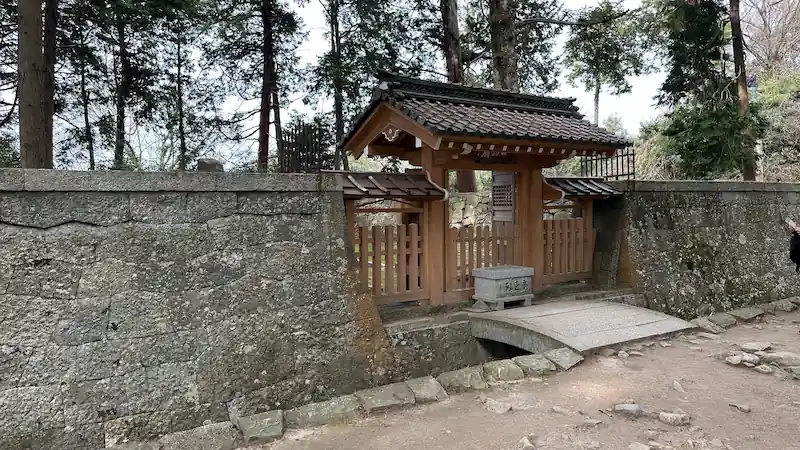
🏛 Overview
On a site believed to be part of the former Ninomaru compound of Azuchi Castle stands the serene main mausoleum of Oda Nobunaga. This memorial was established in February 1583 (Tenshō 11) by his senior retainer, Hashiba Hideyoshi (later Toyotomi Hideyoshi). Hideyoshi interred Nobunaga’s beloved personal items, including his sword, eboshi (formal headwear), and hitatare (formal robe). On June 2 of the same year, a grand first anniversary memorial service was held, attended by members of the Oda family and many retainers. Even today, a ceremony known as the “Nobunaga Memorial” (*Nobunaga-ki*) is conducted every June 2 at Sōken-ji’s temporary main hall. The stone walls and foundation stones still surrounding the mausoleum quietly evoke the achievements of Nobunaga and the tumultuous Sengoku era.
🗺 Address: Shimo Toyoura, Azuchi-cho, Omihachiman City, Shiga Prefecture
🚶 Access
From the Bussoku-seki, continue toward the main keep and take the small path on the left.
⏳ Recommended Visit Time
Quick highlights: about 5 minutes; for a more in-depth visit: about 20 minutes
📍 Highlights
- Main Mausoleum: The site where Nobunaga’s cherished belongings were buried, offering a tangible link to his legacy.
- Surrounding Stonework: Remnants of stone walls highlight the grand scale and craftsmanship of Azuchi Castle.
- Seasonal Beauty: In spring, cherry blossoms bloom around the mausoleum, and in autumn, vibrant foliage creates a striking backdrop.
📌 Trivia
- Surprising Historical Background: The first memorial service was held on June 2, 1583, organized by Hideyoshi and attended by the Oda clan and retainers.
- Little-Known Details: Every June 2, the “Nobunaga Memorial” is still observed at Sōken-ji’s temporary main hall.
- Famous Connections: The mausoleum was built by Hideyoshi, who also interred Nobunaga’s treasured personal effects here.
Ninomaru Ruins
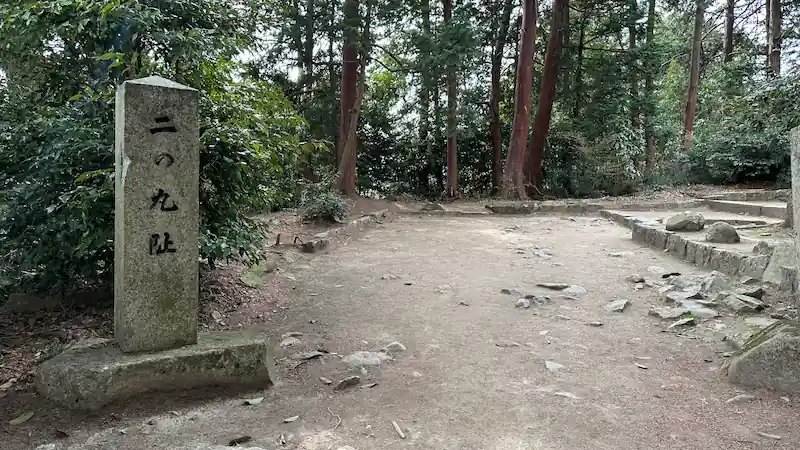
🏛 Overview
The Ninomaru Ruins at Azuchi Castle mark one of the castle’s main enclosures and were a core part of Nobunaga’s formidable stronghold. This area was believed to have been home to Nobunaga’s senior retainers and family members, functioning as the political and military heart of the castle complex. Today, the site is most notable for housing the mausoleum of Oda Nobunaga, built by Toyotomi Hideyoshi, which continues to convey the legacy of the Sengoku period. Surrounding the mausoleum, visitors can still see scattered foundation stones and stone walls that offer a glimpse into the castle’s original scale and structure.
🗺 Address: Shimo Toyoura, Azuchi-cho, Omihachiman City, Shiga Prefecture
🚶 Access
Located in the same area as Nobunaga’s Main Mausoleum.
⏳ Recommended Visit Time
Quick highlights: about 5 minutes; for a more immersive experience: about 15 minutes
📍 Highlights
- Nobunaga’s Main Mausoleum: The resting place where Toyotomi Hideyoshi buried Nobunaga’s treasured belongings in 1583. Each June 2, the “Nobunaga Memorial” ceremony is still held here.
- Stone Wall Remains: The surrounding stonework showcases the impressive scale of Azuchi Castle’s construction.
- Seasonal Beauty: In spring, cherry blossoms brighten the site; in autumn, colorful foliage frames the ruins with striking contrast.
📌 Trivia
- Surprising Historical Background: The Ninomaru area was the castle’s political and military hub, where Nobunaga’s family and closest retainers once lived and worked.
- Little-Known Details: Around the mausoleum, you can find traces of samurai residences that reveal the original layout of this strategic enclosure.
- Famous Connections: The presence of Nobunaga’s mausoleum makes this site one of the most poignant places to feel the spirit of the Sengoku era.
Honmaru Ruins
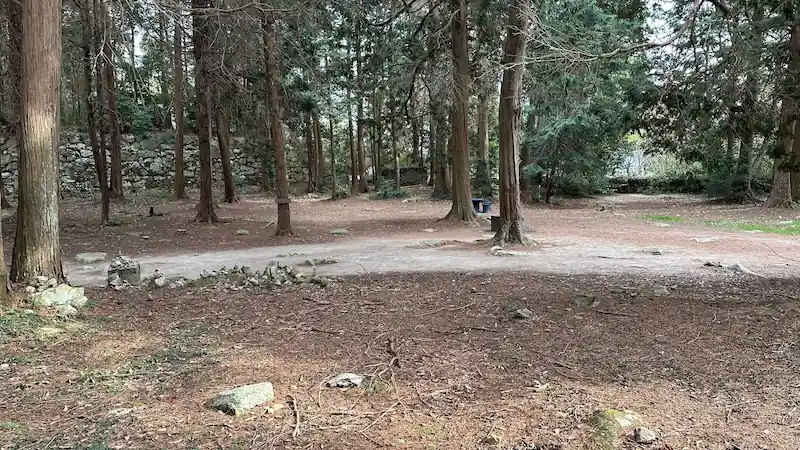
🏛 Overview
The Honmaru Ruins mark the very heart of Azuchi Castle, the central enclosure where Oda Nobunaga concentrated the core functions of his revolutionary stronghold. This area, also referred to as the “Senjojiki,” was said to be a vast plaza where grand halls once stood. Excavations have uncovered 119 foundation stones laid out in a grid pattern, offering clear evidence of the impressive scale and unique architectural plan of the compound.
🗺 Address: Shimo Toyoura, Azuchi-cho, Omihachiman City, Shiga Prefecture
🚶 Access
From the Ninomaru Ruins, return to the main path and proceed toward the tenshudai (main keep base).
⏳ Recommended Visit Time
Quick highlights: about 5 minutes; for a deeper exploration: about 15 minutes
📍 Highlights
- Building Foundation Stones: 119 grid-aligned foundations remain here, illustrating the advanced construction techniques and immense scale of the Honmaru.
- Stone Walls: The surrounding stonework still conveys the power and defensive capabilities of Nobunaga’s Azuchi Castle.
- Seasonal Beauty: In spring, cherry blossoms accent the site; in autumn, colorful foliage creates an atmospheric blend of nature and history.
📌 Trivia
- Surprising Historical Background: The design of the Honmaru Palace closely resembled Kyoto Imperial Palace’s Seiryōden, suggesting it may have been built to host an imperial visit.
- Little-Known Details: From the Honmaru, you can get an up-close view of the tenshudai, the massive stone base of the famous Azuchi Castle keep.
- Famous Connections: This was the central hub of Nobunaga’s castle—standing here, you can truly feel the history of the Sengoku era.
Tenshudai (Main Keep Base) Ruins
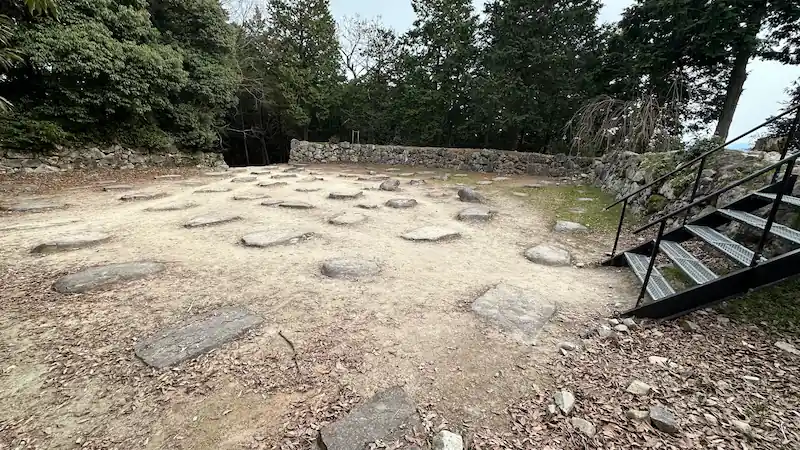
Click here to view the panorama photos
🏛 Overview
The Tenshudai Ruins are the remains of the massive stone base that once supported Azuchi Castle’s extraordinary main keep, built by Oda Nobunaga at the very heart of his revolutionary fortress. Rising six stories above ground and one below, the tenshu reached an estimated height of 32 meters. Its bold, ornate design incorporated innovative religious symbolism unseen in prior Japanese castles. Although the tower itself no longer survives, the sturdy stone walls and foundation stones remain, powerfully evoking its grandeur.
🗺 Address: Shimo Toyoura, Azuchi-cho, Omihachiman City, Shiga Prefecture
🚶 Access
Nearest station: About 30 minutes on foot (approx. 2.5 km) from JR Biwako Line “Azuchi Station”
⏳ Recommended Visit Time
Quick highlights: about 5 minutes; for in-depth exploration: about 30 minutes
📍 Highlights
- Stone Walls of the Base: The surrounding walls rise approximately 2 meters tall, showcasing the high-level masonry techniques of the period.
- Foundation Stones: Rows of foundational stones reveal the scale and layout of the original keep, helping you envision its towering presence.
- Seasonal Beauty: Cherry blossoms in spring and vibrant autumn foliage beautifully complement the ruins.
📌 Trivia
- Surprising Historical Background: The Azuchi Castle tenshu was radically different from conventional castles, blending religious motifs with fortress design.
- Little-Known Details: The arrangement of the stones has revealed details of the underground floor structure, demonstrating advanced construction techniques.
- Famous Connections: Nobunaga built this magnificent keep to project his power and vision, reflecting his groundbreaking ambitions.
- The Main Pillar Mystery: Typically, such keeps had a massive central pillar resting on a foundational stone. However, here no such foundation was found—only a hole. Some theories suggest the pillar was set into this hole, adding to Azuchi Castle’s many enigmas.
- Scale of the Base: In person, the platform may not feel enormous, but research shows its size was comparable to Himeji Castle’s keep base—had the tenshu survived, it would have inspired the same awe as Himeji’s towering main keep.
Three-Story Pagoda
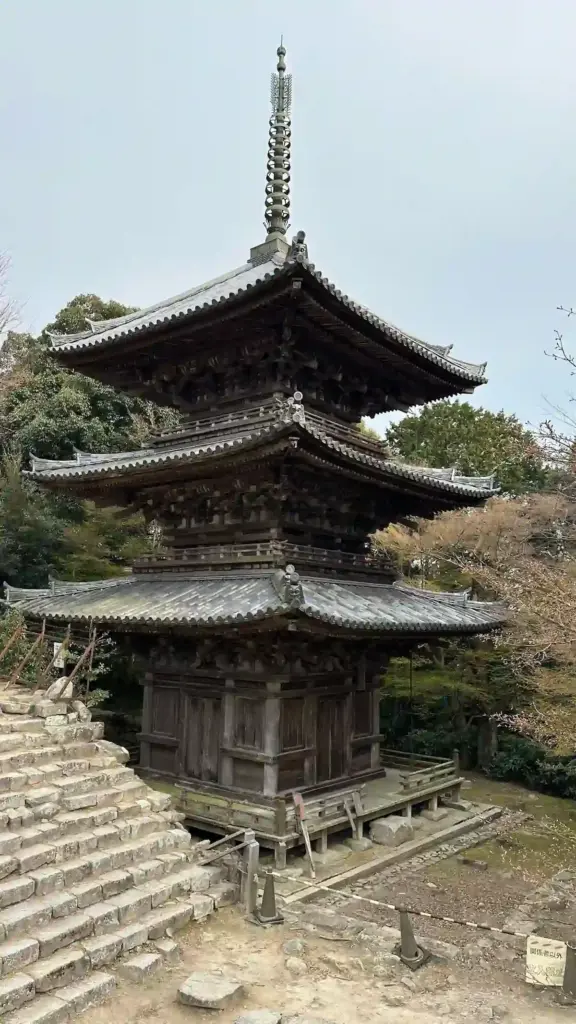
🏛 Overview
Standing within the Azuchi Castle Ruins, the Three-Story Pagoda of Soken-ji Temple is a remarkable structure originally built in 1454 (Kyotoku 3) during the Muromachi period. It was originally part of Choju-ji Temple in Koka District, Omi Province, and was relocated here by Oda Nobunaga when he constructed Azuchi Castle. The pagoda is a san-gen sanju no toba, a three-bay, three-story tower with tiled roofs, and is designated as an Important Cultural Property of Japan.
| Year of Construction | 1454 (Kyōtoku 3, Muromachi Period) |
|---|---|
| Relocation | Relocated by Nobunaga from Chōju-ji Temple in Kōka around 1575–1576 (Tenshō Period) |
| Repairs & Restoration | Repaired in 1555 (Tenbun 24); additional repairs by Toyotomi Hideyori in 1604 (Keichō 9) |
| Current Condition | Still standing at the site, weathered but retaining the beauty of its wooden joinery and atmosphere |
| Cultural Property Designation | Designated as an Important Cultural Property of Japan |
| Remarks | After typhoon damage in 2017 (Heisei 29), restoration work was carried out in autumn 2018 (Heisei 30) |
🗺 Address: 6367 Shimo Toyoura, Azuchi-cho, Omihachiman City, Shiga Prefecture
🚶 Access
Nearest station: About 20 minutes on foot (approx. 1.5 km) from JR Biwako Line “Azuchi Station”
⏳ Recommended Visit Time
Quick highlights: about 5 minutes; for a deeper appreciation: about 20 minutes
📍 Highlights
- The Pagoda: Built in the Muromachi era and relocated here by Nobunaga, it is a rare example of medieval architecture and an Important Cultural Property.
- Nio Gate: The imposing gate, constructed in 1571, is another Important Cultural Property within the temple precincts.
- Seasonal Beauty: Cherry blossoms in spring and colorful autumn foliage offer stunning scenery against the backdrop of historic architecture.
📌 Trivia
- Unexpected Historical Background: This pagoda was moved from Choju-ji Temple in Koka, highlighting Nobunaga’s ambition to integrate prominent structures into Azuchi.
- Little-Known Details: The temple grounds also preserve the Nio Gate and other Muromachi-period structures of great historical importance.
- Connections to Notable Figures: Soken-ji was founded as Oda Nobunaga’s family temple and remains closely linked to his legacy.
Nio Gate
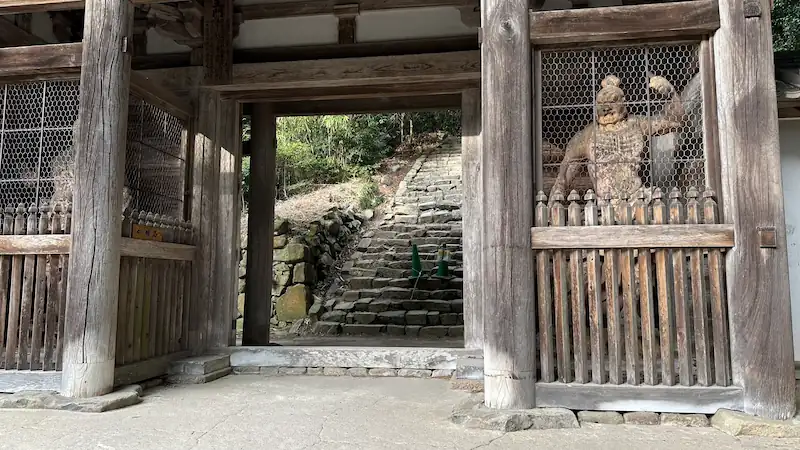
Click here to view the panorama photos
🏛 Overview
The Nio Gate of Soken-ji Temple, part of the Azuchi Castle Ruins, is a striking example of Muromachi-period temple architecture and is designated an Important Cultural Property. Originally located at a temple in Koka District, it was moved here by Oda Nobunaga when Azuchi Castle was built. The gate is built in the two-story tower style (romon) and houses a pair of fierce Kongorikishi guardian statues that convey the solemn atmosphere of the Sengoku period.
| Year of Construction | 1571 (Genki 2) |
|---|---|
| Builder | Shunko Yamanaka, a samurai of Kōka |
| Relocation | During the Tenshō Period (circa 1571), moved into Azuchi Castle by Nobunaga |
| Structure & Features | Irimoya-style, two-story structure with tiled hip-and-gable roof; latticework enshrining Kongōrikishi statues |
| Cultural Property Designation | Both the gate and the Kongōrikishi statues are designated as Important Cultural Properties of Japan |
| Current Condition | Still standing atop a stone staircase—weathered but retaining dignified presence |
| Remarks | An introductory highlight of any castle tour—a genuine relic from the period of Nobunaga’s castle construction |
🗺 Address: Shimo Toyoura, Azuchi-cho, Omihachiman City, Shiga Prefecture
🚶 Access
Nearest station: About 30 minutes on foot (approx. 2.5 km) from JR Biwako Line “Azuchi Station”
⏳ Recommended Visit Time
Quick highlights: about 5 minutes; in-depth exploration: about 20 minutes
📍 Highlights
- Nio Gate: A Muromachi-era two-story romon-style gate relocated by Nobunaga and designated an Important Cultural Property.
- Kongorikishi Statues: The imposing pair of guardian statues within the gate symbolize strength and protection.
- Seasonal Beauty: Cherry blossoms and autumn foliage enhance the historic atmosphere.
📌 Trivia
- Unexpected Historical Background: This gate was also relocated from a temple in Koka District, part of Nobunaga’s grand vision for Azuchi.
- Little-Known Details: Along with the pagoda, the Nio Gate is one of the few surviving structures of Soken-ji, underscoring its historical significance.
- Connections to Notable Figures: Soken-ji was built as Nobunaga’s family temple, intimately tied to his life and legacy.
Hearth Remains (Kamado Ato)
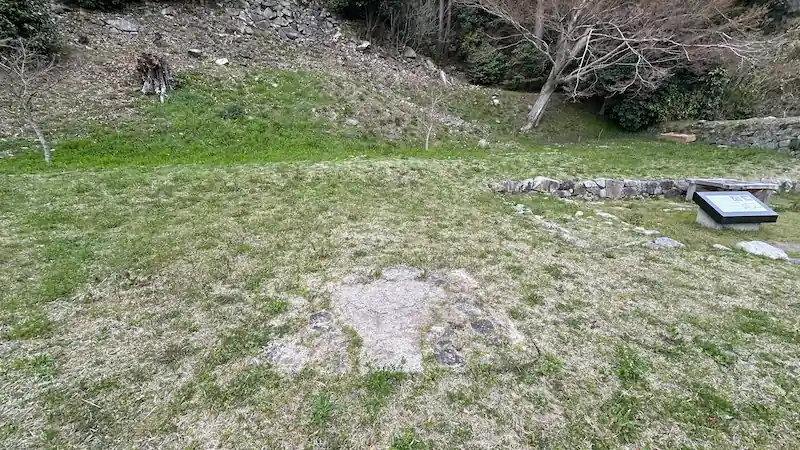
🏛 Overview
In the upper western enclosures of the Azuchi Castle Ruins, several hearth remains (kamado ato) have been unearthed, offering vivid evidence of daily life within the castle. These hearths were used for cooking and heating, illustrating that Azuchi Castle was not just a military fortress but a functioning residence. In addition to stone hearth outlines, shallow dish-shaped depressions filled with charcoal and scorched earth have been found, thought to be either traces of fire damage or remnants from dismantling and rebuilding hearths over time.
These archaeological features allow visitors to imagine the everyday routines of those who once lived and worked in the castle during the Sengoku period.
🗺 Address: Shimo Toyoura, Azuchi-cho, Omihachiman City, Shiga Prefecture
🚶 Access
From the Azuchi Castle entrance, proceed to the right and you will find them along the path.
⏳ Recommended Visit Time
Quick highlights: about 5 minutes; deeper exploration: about 15 minutes
📍 Highlights
- Hearth Remains: Scattered across the upper western enclosure, these stone hearth outlines offer a tangible link to daily life in the castle.
- Charred Soil and Ash: Charcoal and scorched earth deposits hint at fire damage or rebuilding activities over the years.
- Seasonal Scenery: Spring cherry blossoms and vibrant autumn leaves enhance the atmosphere around these evocative ruins.
📌 Trivia
- Unexpected Historical Background: The discovery of these hearths proved that Azuchi Castle was a place of residence, not merely a military headquarters.
- Little-Known Detail: The dish-shaped depressions filled with burnt remains may be evidence of old hearths being broken up to build new ones.
- Connections to Notable Figures: These remains are part of the castle life that unfolded under Oda Nobunaga’s rule.
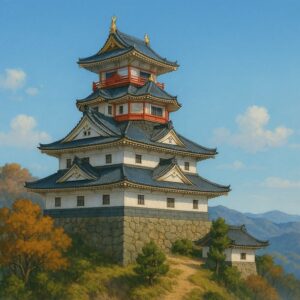





comment